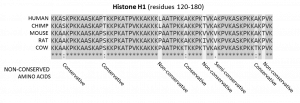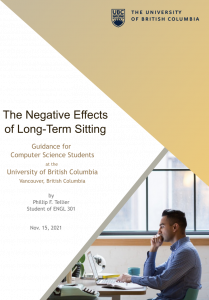The formal report proposal, progress report, and survey below were instrumental in the planning process of writing a thorough report on the “negative effects of long-term sitting” for the computer science student society (CSSS). They were sent early on to Dr. Erika Paterson, a technical writing professor at the University of British Columbia, for feedback. The proposal and progress report demonstrate the ability to initiate and organize a large writing project within an organization. The survey shows I can design a way to gather data from many different people.
Formal Report Proposal
To: Dr. Erika Paterson
From: Phillip Tellier
Date: October 14, 2021
Subject: Proposal for a Report on Reducing the Negative Effects of Sitting for BCS Students
Intended Audience
The primary audience for the report will be UBC students in the Integrated Computer Science program (BCS program) at the University of British Columbia. I plan to work with the computer science student society (CSSS) on my formal report. They can distribute the report to students who are interested in learning more about how sitting for too long can affect them. As such, the secondary audience is partly the executive team of the CSSS. Other possible readers are UBC faculty who would approve the report distribution, and anyone who students might choose to share the report with.
Introduction
There is both concern and misconception about the effects of regularly sitting for long periods of time in the workplace. Students in the BCS program seem to have a general understanding that being sedentary for too long or often is bad for your health. Unfortunately, they are not certain of the best strategies to negate these issues or the magnitude of the problem.
Statement of Problem
Computer science students are required to sit for long periods of time to complete coursework. Many graduates will reach a career in software development, data analytics, and information technology, where most work is done at a sitting desk. Even in the roles that aren’t directly applicable to computer science which students might fill, sitting is common. Administration, and management jobs are examples. It is well known that a sedentary lifestyle is bad for one’s heath, but not specifically the likelihood of common negative effects. For example, on average how much is lifespan shortened by a sitting job compared to a more active role? What proportion of workers who sit for the majority of their shift will develop chronic back pain? It is important that students be aware of the risks as well as possible solutions so that they have they can be proactive in their response.
Proposed Solution
Knowing more about the detrimental effects of sitting gives BCS students the choice to withdraw and pursue options that are healthier. Knowing a remedy for the effects, they can apply it. Hence, an investigation of health effects and health solutions to sitting should be conducted to aid them. I will research common disorders caused by sitting, the possible lifestyle adjustments, and modifications to office equipment that students can make to protect their health. The findings will be presented in a formal report.
Scope
To be thorough, the proposed investigation of how sitting affects students will look into the following:
- The opinions of BCS students on how detrimental sitting can be, and what will effectively combat the problem
- Health disorders commonly caused by long-term sitting such as back pain and obesity.
- Comparing the “standing desk” to a sitting desk. Is it a viable alternative?
- The importance of proper sitting posture
- Exercise as a way to prevent or undo the negative effects
Methods
I will ask BCS students to participate in a survey that collects their opinions. I will create graphics of the statistics I collect for my report. I will also explore peer reviewed research publications to answer the questions on health effects and possible solutions. This will include both primary and secondary sources.
My Qualifications
As a BSc graduate in biochemistry from the University of Victoria, I am well equipped to write a formal report on scientific research. Since biochemistry is related to the health sciences, I will be quick to grasp the ideas presented in literature. As a BCS student who feels well connected to the BCS community. I should have no trouble finding students to complete a survey. I have personally experienced some of the effects of sitting for far too long, and have heard the complaints. Therefore, I am well acquainted with the issue.
Conclusion
There is no doubt that long-term sitting presents some detriment to health, so it’s important that the danger is quantified and anyone at risk is warned. In this way, we can prevent ill health by encouraging students to take action according to the science. Please inform me if I have your approval for this research project at your earliest convenience.
Progress Report for the Formal Report

MEMORANDUM
To: Dr. Erika Paterson, English professor at the University of British Columbia
From: Phillip Tellier, Student of ENGL 301 at the University of British Columbia
Date: October 28, 2021
Subject: Progress Report for Formal Report on the Effects of Long-Term Sitting
Dear Dr. Erika Paterson,
I have begun to plan and research for my formal report on the effects of long-term sitting. The audience for this report is primarily UBC computer science students. I am working with the computer science student society (CSSS) to create this report. Specifically, I will present my report to the vice president of volunteering services, Shubha Bhalla. He will help distribute the report to students interested in the findings via email and social media. Other potential readers are anyone besides students following CSSS social media and emails.
The report’s purpose is to raise awareness about what students can do to protect their health from sitting too long. This includes fixing misconceptions about solutions that actually do not work. It is important that students are well informed on risks to their health and possible fixes. If they are, students can be proactive and improve their future quality of life against problems like back pain and obesity.
My research process will proceed in this order:
- Compose a survey of the opinions of computer science students. The survey will gauge how much misinformation there is about sitting. It will also gauge the level of concern students have.
- Identify the problem at hand by administering the survey to students. I will aim for 25 minimum completed surveys. Donut charts will be created to display the results in my report.
- Explore research publications on health disorders caused by long-term sitting. I will also research exercise, standing desks, and better posture as potential remedies to the problem.
I have also planned a writing schedule for my work with these deadlines:
- Oct. 29: compose the survey
- Nov. 1: administer the survey to students
- Nov. 5: create informational graphics for and write about the survey results
- Nov. 12: research negative effects of sitting and possible solutions. Write the main body of the report
- Nov.16: rough draft of the formal report
- Nov. 26: finish editing and present the final draft
This amount of work is reasonable given the timeframe because I adequately narrowed the scope of the research. There is also no cost involved besides my labour. Please let me know if the survey conforms to the ethical survey standards that UBC has. This survey is linked below. If you need to, reach out with suggestions for my report writing and research process.
Enclosure: Survey for computer science students on the effects of long-term sitting
Survey for the Formal Report
Introduction: I, Phillip Tellier, am completing a technical writing project as part of my computer science degree program at UBC. The project investigates the negative effects of sitting for too long, particularly for computer science students during their degree and their future careers. This survey collects student’s opinions on the severity of the issue and what changes can be made to fix the problem. This allows me to quantify awareness of the negative health effects and possible solutions. This will determine the urgency of student re-education. The survey results will be presented in a formal report and distributed electronically by the computer science student society (CSSS). It will be available electronically to any students that are interested via CSSS social media. The survey is optional and your answers will remain anonymous. Nevertheless, I thank you if you do decide to participate.
Question 1: Sitting for long periods of time everyday…
- …does not affect your health.
- …is somewhat bad for your health.
- …is bad for your health.
- …is very bad for your health.
Question 2: Which of the following health disorders can be caused by sitting for too long (multiple selections are possible):
- Back pain
- Obesity
- Parkinson’s Disease
- Asthma
- Deep Vein Thrombosis
Question 3: A standing desk compared to a sitting desk is…
- …just as unhealthy.
- …healthier but still problematic.
- …healthier and a great solution to the problem of sitting for too long.
Question 4: Proper posture while sitting will…
- …not reduce the negative effects of sitting for too long.
- …reduce the negative effects of sitting for too long.
- …prevent any negative effects of sitting for too long.
- …prevent any negative effects of sitting for too long only if I get enough exercise.
Question 5: Regular exercise will…
- …not reduce the negative effects of sitting for too long.
- …reduce the negative effects of sitting for too long.
- …prevent any negative effects of sitting for too long.
- …prevent any negative effects of sitting for too long only if I maintain proper posture.

